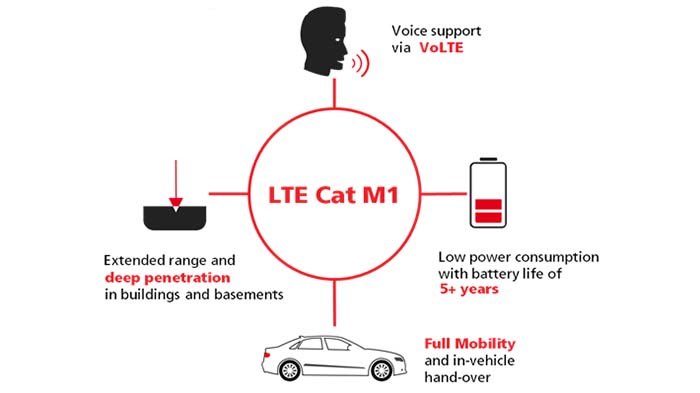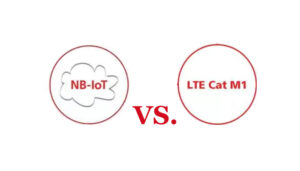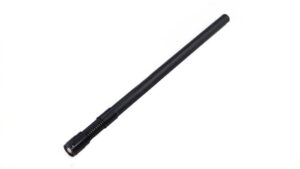Today, we talk about the LTE-M technology and the LTE Cat M1 technology communications.
LTE-M technology communication
LTE-M technology is a cellular technology specifically designed to meet the needs of the Internet of Things (IoT) or machine-to-machine communication applications.
LTE-M technology is the simplified industry term for the LTE-MTC low power wide area (LPWA) technology standard published by 3GPP in the Release 13 specification. It specifically refers to LTE CatM1, suitable for the IoT. Commercial launches of LTE-M networks will take place globally in 2017.
What is LTE Cat M1?
The LTE Cat M1 in LTE-M technology is a low power wide area (LPWA) air interface that can connect to IoT and M2M devices with medium data rate requirements (upload and download speeds in half-duplex mode is 375 kb / s).
It offers longer battery life and wider coverage compared to standard cellular technologies such as 2G, 3G, and LTE Cat 1. The main functions are as follows.

Voice function support by VoLTE
Full mobility and in-vehicle switching
Low power consumption
Expand coverage
Exceed expectations
LTE Cat M1 is part of the 3GPP Release 13 standard and also defines the narrowband Internet of Things (NB-IoT or LTE Cat NB1). Both are LPWA technologies in the licensed spectrum.
The Cat M1 has uplink and downlink speeds of 375 kb / s in half-duplex mode, especially for IoT applications with low to medium data rate requirements.
At these speeds, the LTE Cat M1 can provide remote wireless firmware updates (FOTA) within a reasonable time frame. This is very suitable for major applications running on devices that have been deployed in the field for extended periods of time.
In some use cases, a single charge can provide up to 10 years of battery life, reducing maintenance costs for deployed equipment even when some terminal equipment is not directly connected to the grid.
Compared to NB-IoT, LTE Cat M1 can handle switching between towers like high-speed LTE, making it ideal for mobile use cases. For example, if a vehicle needs to go through several different network units to move from point A to point B, the Cat M1 device behaves like a cell phone without losing connectivity.
In contrast, NB-IoT devices need to reestablish new connections at specific points after arriving at a new network unit.
Another big advantage is that it supports voice capabilities via VoLTE (Voice over LTE). This means that it can be used for applications that require some human interaction, such as certain health and safety applications (such as instant solutions and alarm panels).
LTE-M technology communication application

What is LTE-M technology used for?
LTE-M technology is a leading LPWA network technology for Internet of Things applications. Used for interconnecting objects such as IoT sensors and actuators, or other industrial devices via radio modules, it complements the landscape of IoT connectivity options to keep the smart revolution going.
Car and transportation
LTE Cat M1 supports full handover between mobile vehicle network units, Very suitable for mobile use cases with low to moderate data rate requirements such as vehicle tracking, asset tracking, telematics, fleet management, and UBI auto insurance.
Smart metering
The Cat M1 is also ideal for monitoring measurement and utility applications through regular and small data transmissions. Network coverage is an important issue in the deployment of smart metering. Meters are typically located in buildings and basements, so expanding the Cat M1’s range can improve coverage in areas that are difficult to cover.
Smart building
The Cat M1 can easily extend the indoor range to provide basic building management functions such as heating, ventilation, air conditioning (HVAC), lighting, and access control. It also has VoLTE voice capabilities, making it very suitable for major applications such as security systems and alarm panels.
Connected health
With enhanced coverage, voice support, and mobility, the Cat M1 is also an air interface option suitable for connected health applications such as outpatient monitoring and instant solutions.
Smart city
In smart cities, the Cat M1 addresses a variety of needs, effectively controls streetlights, determines waste management collection schedules, identifies free parking spaces, monitors environmental conditions, and within a few milliseconds. You can investigate the road conditions.
Besides the What is LTE-M Technology article, you may also be interested in the below articles.
PCB Antenna VS. External Antenna
Ceramic Antenna VS. PCB Antenna, A Comparison Guide
Wifi vs. 5G, is 5G better than Wifi?
Mobile Networks’ Evolution From 1G To 5G



